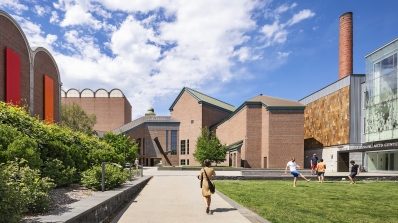Past Exhibitions
Art and Society in the Papuan Gulf of New Guinea
Coaxing the Spirits to Dance
Coaxing the Spirits to Dance is first major exhibition about the art of the Papuan Gulf in over forty years. This exhibition will explore the relationship between social life and artistic expression since the nineteenth century in one of the most important art-producing regions of Papua New Guinea. It includes one hundred magnificent art objects from the Hood’s own important collection of Melanesian art, including the Franklin Family Collection, and select other public and private collections. The exhibition features ancestor boards, masks, drums, skull racks, and personal items. It will examine the effects of colonialism on artistic production, the variation of styles among differing social structures and cultural practices, and the relationship between patterns of collecting and interpretations of art and culture in the Papuan Gulf. A fully illustrated scholarly catalogue accompanies the exhibition. Coaxing the Spirits to Dance will travel to The Metropolitan Museum of Art from October 24, 2006, through December 2, 2007.
Rembrandt’s mastery of the printmaking medium and his sensitive depiction of the human condition are unsurpassed. His numerous etchings covered the full range of styles and subjects for which he is celebrated as a painter and draughtsman, including self-portraits, scenes from the Bible, vignettes of everyday life, and character studies. Famously experimental, Rembrandt often reworked his copper plates to improve and extend their expressive power. The results can look startlingly modern and continue to inspire artists today. Drawing on many pictorial traditions and familiar themes, the works in the Hood’s collection represent Rembrandt’s achievements as a printmaker from his first etchings in the 1620s to his death forty years later. This exhibition is presented in celebration of the artist’s four hundredth birthday and will be accompanied by an illustrated brochure.
The Eyes of Gutete Emerita
Alfredo Jaar
The Eyes of Gutete Emerita by filmmaker and photographer Alfredo Jaar grew out of his visit to Rwanda a few months after the 1994 genocide. This photo-based work, which combines images and text, focuses on the suffering of one individual, Gutete Emerita, who lost her husband and two sons in the mass killing of Tutsis at a church forty miles south of the capital of Kigali. Jaar chose not to photograph the remains of bodies still lying on the ground at the massacre site and instead directs our attention to the survivors who must live with the memory of what they saw. An illustrated brochure accompanies this exhibition.
Religious Images in 16th-Century Europe
Sacrilege and IdolatryVisual Lessons in Biology
Life Forms
Life Forms explored the boundary between art and science with anatomical atlases, student drawings, wax and plaster sculptures, films and diagrams of cellular processes, and the National Institute of Health’s Visible Human Project. The exhibition coincided with Dartmouth’s spring 2006 Humanities Institute, “Visual Pedagogy and Culture in the Life Sciences.”
Myth of the Noble Savage
